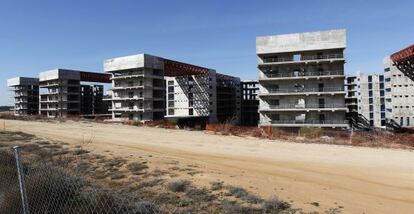Built in a bubble
Hospitals planned during Spain's boom languish half-finished or devoid of patients

All it takes is a climb up a small hill outside the new residential neighborhood of Santa María de Benquerencia, five minutes out from downtown Toledo, to see an amazing sight. Depending on the angle, what was going to be "the biggest hospital in Europe" -- all 10 buildings and 360,000 square meters of it -- makes even the Alcázar, perched magnificently atop the old part of town, seem small and puny by comparison.
"I can tell you exactly how long construction work has been at a standstill: 13 months, as long as my daughter has been out of work," laments Luis Gómez, 64, standing next to the metal fence protecting the gigantic cement hull that should have contained the hospital.
Gómez's daughter, a 27-year-old clerical worker, was one of around 500 employees who were fired when the Castilla-La Mancha regional government decided to halt construction work and rescind the builders' contracts in late 2011. Regional premier María Dolores de Cospedal of the Popular Party (PP), just elected to the post then, announced that there was "no money" to complete the project the way it had been planned by the outgoing Socialist administration. The new austerity expected of the regions -- particularly this region, more indebted than most -- meant the ax for major infrastructure projects such as this one. By then, however, the hospital was 30 percent done, at a cost of 140 million euros.
Toledo's "mega-hospital" may top the record charts -- 36 projected operating theaters, 800 rooms, 200 doctor's offices -- but it is by no means the only unfinished hospital in Spain. Many other municipalities sport large concrete skeletons that were meant to become brand new medical centers. In other cases, the buildings were completed but never opened to the public, since that would be too expensive. The problem is that even a closed hospital is costly to keep: the one in Collado Villalba, north of the city of Madrid, costs the region 900,000 euros a month even though it is not operational. The regional government is forced to pay the fee to Capio, the company that built it and will run it for the next 30 years.
During the upward economic cycle, propaganda came before information"
New hospitals became a regular campaign promise across the country during the period that Juan Oliva, president of the Association of Health Economics, describes as "the prodigious decade of recent economic growth," which lasted until the year 2008. This period was marked by "archetypes of bad government when it comes to embarking on risky, poorly thought-out investments, localism in the development of service centers, and disregard for technical references during the planning stage."
Then the crisis came, and the hospital bubble burst like all the other bubbles. Those old campaign promises are now heavy burdens for many regional budgets -- those very same budgets that now keep getting scaled back. Health expenditure, until recently an untouchable budget item, has lost 6.7 billion euros across Spain since 2010.
Many experts now wonder if all those projected hospitals were necessary in the first place. The Valencia health service continues to function - at least according to its managers -- even though the new hospitals of Llíria and Gandia are finished but sitting empty, while those of Torrent, Vall d'Uixó, Peñíscola, Ontinyent and Benidorm never made it past the blueprint stage.
"There is no doubt that short-term, campaign-oriented interests played a determining role," says Oliva, speaking not just about the Valencia region but about Spain as a whole. "Without proper information, it is very hard to know to what extent these investments were justified or not. And unfortunately, during the last upward economic cycle, propaganda got ahead of information [...] as far as the activities of many ministries and regional departments are concerned."
Governments must keep paying the companies that will run the hospitals
One clear example is the Madrid region. Former premier Esperanza Aguirre made a bold promise during her 2003 bid for re-election: she would build no fewer than seven hospitals during a single political term. One of these was in fact a transfer: Puerta de Hierro hospital was moved from an old, obsolete building to a new location in Majadahonda, around 20 kilometers northwest of the capital. The other six were completely new, which is to say that they were going to serve people who were now being forced to go to a different town to see a specialist. The public works contracts were awarded in 2005, following the British model: the companies build and provide non-sanitary services, and the construction does not count as debt for the public deficit. The centers were not ready in time for the following campaign, but Aguirre managed to open them all just a month apart in 2008, barely in time to avoid the economic crisis.
Were they necessary? Were they designed according to some plan? If they were, this plan never reached the public domain. Just five years after their inauguration, Madrid has introduced a savings scheme that includes the complete privatization of six of those hospitals, and assumes that two of them -- Carlos III and La Princesa -- are wholly unnecessary. The former will likely be turned into a mid-to-long-term patient care center, while the latter was going to be a senior center until public protest made the regional government change its mind. "In Madrid's case, it's clear that there was no serious planning," says Félix Lobo, a professor of applied economics at Carlos III University. "There is not one document to support the need for so many hospitals at the same time. I asked the health department for the health infrastructure plan and I got nothing. A high-ranking official admitted to me that there isn't one."
Aguirre managed to inaugurate the first batch of hospitals. During her second campaign run she promised four more, this time entirely private in nature. Of these, Móstoles and Torrejón de Ardoz are already operational. The one in Carabanchel was ultimately discarded and replaced with a deal for the military hospital Gómez Ulla to treat local residents. The fourth one, in Collado Villalba, is a perfect example of how the hospital bubble went bust. The regional premier went so far as to have the project declared "of general interest" in order to cut through the zoning red tape. The center got built, but remains closed at least until December of this year.
Capio, the contractor, says it has nothing to do with the decision to keep the hospital closed. The 900,000 euros a month it receives to maintain the hospital represents "a financial effort" for the operator because it is "below what operational figures would be if the center were open," said a company spokesperson.
We have seen an alliance between builders, regional and local politicians"
"Hospital growth is not homogeneous across the regions," says Salvador Peiró, of the Higher Research Center for Public Health (CSISP), an agency that answers to the Valencia government. "It is concentrated in Madrid, Castilla-La Mancha, Valencia and Andalusia, although in the latter region we are talking about the so-called 'high-resolution hospitals,' which hardly have any beds." In his opinion, the increase in health spending was extremely nepotistic and occasionally linked to property development strategies. "This explains why new hospitals were built and where."
There are similar examples in many other regions. Construction of the new hospital center in Vigo, the most saturated area of Galicia, has been on hold since the summer. The main building is up, but the regional government -- the Xunta -- is seeking new sources of financing. Meanwhile, the new hospital in Cáceres, Extremadura, was first announced in 2002, tendered in 2006 and remains half-built, with no more construction activity ongoing since April. The current PP government is now working towards a public-private partnership as "the only possible formula in the current scenario," according to a regional spokeswoman.
The government of Castilla-La Mancha has vowed to open the Toledo hospital this term, though not according to the "disproportionate" plan drawn up by the previous Socialist administration, said a regional spokeswoman, who would not provide any details about the new, reformed project. A draft of the new plan commissioned by regional premier De Cospedal from a consulting company called Mensor talks about simply finishing the outside of some buildings and leaving empty entire sectors with a total capacity for 400 beds. The spokeswoman said that this draft might change and that the company will not be getting the more than 60,000 euros that the functional plan costs until the final version is turned in.
The region's Socialist opposition complains that the center had funding but that De Cospedal put it on hold for political reasons. The regional health commissioner, José Ignacio Echániz, asserts that the Toledo hospital will eventually open, but that two other projected health centers in Guadalajara and Cuenca will have to wait. "The new government walked into a crisis and a pile of debt and these two projects will not be taken up again until funding is found," a spokeswoman says.
Andalusia, which cannot fall back on the excuse of bad management by the previous administration (the Socialists were re-elected, whereas most other regional governments fell to the PP during the last elections), also has several projects on hold. Health commissioner María Jesús Montero confirmed a few weeks ago that planned buildings whose construction is yet to begin will not be going up until the budget situation improves. This means that the future hospitals of Cádiz and Málaga or Jaén's "health city" are indefinitely on hold. Others, like Hospital Clínico in Granada, are practically finished but there is no money for the medical equipment. In the Basque Country, construction of a hospital in Eibar will not get underway next year as originally planned due to lack of funding.
José Ramón Repullo, a professor of health planning and economics at the National School of Health, does not like to talk about a hospital bubble because "it lacks one of the speculative characteristics of a bubble: buying in order to sell." He defines the situation differently: "What we have here is essentially an alliance between builders, regional politicians and local politicians, with the accomplice silence of the other players, who dare not raise their voices. For who will dare say that there is no need for a hospital in a given place, without running the risk of being run out of town by local residents and businesspeople with an interest in the project?"
With reporting by Reyes Rincón and Ania Elorza.
Tu suscripción se está usando en otro dispositivo
¿Quieres añadir otro usuario a tu suscripción?
Si continúas leyendo en este dispositivo, no se podrá leer en el otro.
FlechaTu suscripción se está usando en otro dispositivo y solo puedes acceder a EL PAÍS desde un dispositivo a la vez.
Si quieres compartir tu cuenta, cambia tu suscripción a la modalidad Premium, así podrás añadir otro usuario. Cada uno accederá con su propia cuenta de email, lo que os permitirá personalizar vuestra experiencia en EL PAÍS.
¿Tienes una suscripción de empresa? Accede aquí para contratar más cuentas.
En el caso de no saber quién está usando tu cuenta, te recomendamos cambiar tu contraseña aquí.
Si decides continuar compartiendo tu cuenta, este mensaje se mostrará en tu dispositivo y en el de la otra persona que está usando tu cuenta de forma indefinida, afectando a tu experiencia de lectura. Puedes consultar aquí los términos y condiciones de la suscripción digital.









































